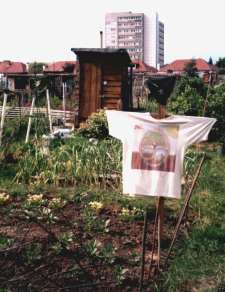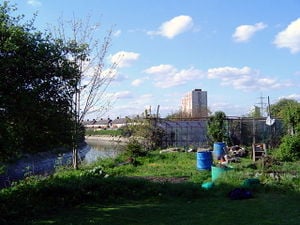
In the United Kingdom, an allotment is a small area of land, let out at a nominal yearly rent by local government or independent allotment associations, for individuals to grow their own food. This could be considered as an example of a community garden system for urban and to some extent rural folk.
The allotment system began in the 18th century: for example, a 1732 engraving of Birmingham, England shows the town encircled by allotments, some of which still exist to this day. Following the Inclosure Acts and the Commons Act of 1876 the land available for personal cultivation by the poor was greatly diminished. To fulfil the need for land allotment legislation was included. The law was first fully codified in the Small Holdings and Allotment Act of 1908, it was modified by the Allotments Act of 1922 and subsequent Allotments Acts up until 1950.
Under the acts a local government is required to maintain an "adequate provision" of land, usually a large allotment field which can then be subdivided into allotment gardens for individual residents at a low rent. The rent is set at what a person "may reasonably be expected to pay" (1950), in 1997 the average rent for a 10 rod (1 E1 m|50.29 metres) plot was £22 a year. Each plot cannot exceed 40 rods and must be used for the production of fruit or vegetables for consumption by the plotholder and their family (1922), the exact size and quality of the plots is not defined. The council has a duty to provide sufficient allotments to meet demand. The total income from allotments was £2.61 million and total expenditure was £8.44 million in 1997.

The total number of plots has varied greatly over time. In the 19th and early 20th century, the allotment system supplied much of the fresh vegetables eaten by the poor. In 1873 there were 244,268 plots and by 1918 there were around 1,500,000 plots. While numbers fell in the 1920s and 1930s, following an increase to 1,400,000 during World War II there were still around 1,117,000 plots in 1948. This number has been in decline since then, falling to 600,000 by the late 1960s. The Thorpe Inquiry of 1969 investigated the decline and put the causes as the decline in available land, increasing prosperity and the growth of other leisure activities.
Despite increased interest in "green" issues from the 1970s which revived interest in allotment gardening the rate of decline was only slowed, falling from 530,000 plots in 1970 to 497,000 in 1977 although there was a substantial waiting list. By 1980 the surge in interest was over, by 1997 the number of plots had fallen to around 265,000, with waiting lists of 13,000 and 44,000 vacant plots.
Allotment users have an organisation that campaigns on their behalf, the National Society of Allotment and Leisure Gardeners, known as the "NSALG".
See also[edit | edit source]
Further reading[edit | edit source]
- The Allotment: Its Landscape and Culture, David Crouch and Colin Ward Paperback 314 pages (June 1, 1997), Publisher: Five Leaves Publications ISBN 0907123910
- The Allotment Handbook, Sophie Andrews, "A guide to promoting and protecting your allotment site." Publisher Ecologic Books
- The Art of Allotments, David Crouch, Publisher: Five Leaves Publications
External links[edit | edit source]
- National Society of Allotment and Leisure Gardeners
- Westcliff on Sea allotments website - includes useful allotment growing tips plus a 'getting started on your allotment' PDF beginners guide
- Allotments4All forum - Lively discussion forum about allotments and gardening
- A Permaculture Allotment? Discussion of allotments from a permaculture perspective
- Uplands Allotments Association Largest Allotments site in Europe